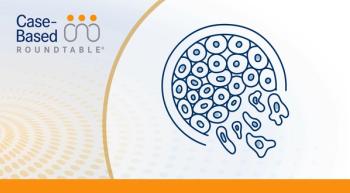
Practical Considerations for the Management of Multiple Myeloma
In the context of multiple myeloma, Peter Voorhees, MD, considers the role of doublet vs triplet therapy, initial therapy selection, and monitoring treatment response.
Episodes in this series

Transcript:
Peter Voorhees, MD: From an efficacy standpoint, studies have made it clear that the triplet strategies in both the relapsed and up-front space have outperformed the doublets. With longer follow-up, we’re starting to see median overall survival improvements as well in many of these trials. There’s no situation in which a doublet will outperform existing triplets with regard to efficacy. When you’re looking at safety, obviously when you add a drug to a backbone, you’re going to increase adverse effects. When you add a CD38 antibody to lenalidomide and dexamethasone, for example, you’re going to increase the likelihood of grade 3 and higher neutropenia. That’s well established. You’ll increase the risk of infection. That’s also well established. In the MAIA trial, there was a slight increased risk of pneumonia in the triplet arm, compared with the doublet arm. When you add bortezomib to the lenalidomide-dexamethasone backbone, you’re going to increase the risk of neuropathy for those patients. That’s well established. There are safety issues that need to be discussed with each patient. But looking at the efficacy data, particularly overall survival advantage when you add either bortezomib or daratumumab to the lenalidomide-dexamethasone backbone, most of us feel that that improved efficacy outweighs the increased risk of those particular adverse effects.
How does our choice of initial treatment impact subsequent choices for later lines of therapy? That’s a fantastic question. Most of the myeloma studies have utilized treatment until disease progression or the emergence of unacceptable adverse effects. Patients who don’t have unacceptable adverse effects on a particular regimen will eventually develop resistance or their myeloma will eventually develop resistance to that regimen. That’s going to impact best-therapy practices in that first relapse. In many instances, a transplant-eligible patient, for example, will go through an initial induction therapy followed by that up-front autologous stem cell transplant and subsequent lenalidomide maintenance therapy. For that patient who’s breaking through lenalidomide maintenance, you’re not going to want to use a lenalidomide-based triplet in that setting because although there are numerous studies looking at lenalidomide triplets in early relapsed myeloma, none of those studies allowed lenalidomide-refractory myeloma. We don’t know how well those regimens perform in the context of randomized trials. In the example that I’ve given, the choice comes down to whether you want to go to a completely… resistant mode of therapy, such as a CD38 antibody with carfilzomib and dexamethasone, or do you want to do a CD38 antibody with pomalidomide and dexamethasone? That’s just 1 example.
I monitor response to therapy as anyone else would. I utilized the International Myeloma Working Group uniform response criteria, and I’m assessing response with each cycle of therapy, determining whether a patient has achieved a partial response, a very good partial response, or a suspected complete response [CR]. For those who have achieved that suspected complete response, we’ll have a discussion with the patient about confirming that with bone marrow examination. As we’re doing that bone marrow examination, an assessment of minimal residual disease [MRD] status is an important consideration.
Generally speaking, achievement of deep response has been associated with improved progression-free and overall survival, so the best treatment response would be an MRD-negative complete response. That said, there are going to be patients who don’t achieve that level of response to therapy. What we don’t know is whether escalating treatment for those who don’t achieve MRD-negative complete responses changes their long-term outlook. Until we have randomized data that support that notion, I’ve been hesitant to escalate therapy simply to make the numbers look better. Those regimens that have a higher probability of achieving that MRD-negative CR are the regimens that are going to give you the best odds of a longer remission and progression-free survival.
Transcript edited for clarity.








































